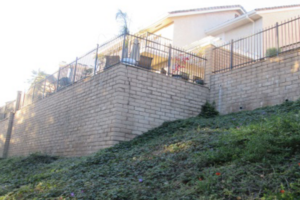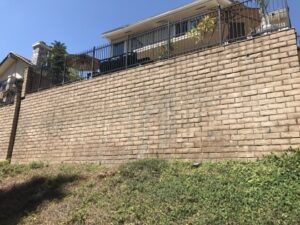 Several years ago, we were asked to assist a homeowners association (HOA) with their damaged retaining walls in Anaheim, California. Twelve properties in the HOA were being affected by the movement of a retaining wall that varied in height up to about 12 feet, which supported the backyards of their stunning view properties.
Several years ago, we were asked to assist a homeowners association (HOA) with their damaged retaining walls in Anaheim, California. Twelve properties in the HOA were being affected by the movement of a retaining wall that varied in height up to about 12 feet, which supported the backyards of their stunning view properties.
When you say you live in Anaheim, many people think you live near the happiest place on earth—Disneyland, which is relatively flat and much closer to the western side of the city. These HOA owners, however, were unhappy campers located in the newer eastern scenic foothill region of the city known for its planned suburban communities with parks, open space, schools and shopping. Many of the homes in the Anaheim Hills have views to the north of the Yorba Linda Hills and the snow-capped mountains beyond, which make them highly desirable and irresistible to buyers—especially young professionals and their growing families.
Problems
Tilting of the HOA wall segments ranged from about 1 inch to more than 3 inches and had caused damage to the backyard improvements of some of the properties. To make matters worse, the wall tilting also caused structural damage (cracks and separations) that threatened the structural integrity of the walls. Something had to be done to stop the damage.
 Helfrich Associates was retained to verify the cause and origin of the damage, and then to develop stabilization plans for the affected walls. We concluded that the walls were tilting due to inadequate foundations, movement of the slope below the walls, inadequate backfill compaction, and water seepage through the wall.
Helfrich Associates was retained to verify the cause and origin of the damage, and then to develop stabilization plans for the affected walls. We concluded that the walls were tilting due to inadequate foundations, movement of the slope below the walls, inadequate backfill compaction, and water seepage through the wall.
We hate to say it again, but hillside communities in Southern California are subject over time to a combination of unstable soils, earthquakes and periodic monsoonal rains. Any of these factors can lead to slope destabilization in hillside home communities, but in Southern California they are frequently all present. The addition of irrigation systems, patio slabs, pools and/or spas in backyards, when not supported properly, can add more stress to the hillside.
Solutions
We developed repair plans for each segment of the affected walls. Our recommended repairs consisted of installing earth anchors through the wall. Although the project was funded by the HOA, the city of Anaheim required us to obtain the written permission of each affected homeowner to install anchors beneath their properties. The anchors that were needed to stabilize the wall extended a maximum of 48 feet into each property.
Conclusions
There are some lessons to be learned. First, when you’re purchasing a new or existing hillside home do not depend only on the builder or a home inspector. Consulting before purchase a professional structural engineer, who is a neutral third party, can save you a lot of headaches.
If something is potentially a future issue with new construction, then you want to know upfront. In a resale situation, structural engineers will tell you what’s wrong, how to fix it and the cost, which can be helpful in negotiating the purchase price of the home.
